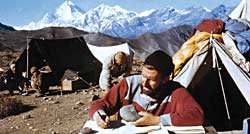 In Toni Hagen's classic work Nepal: The Kingdom in the Himalaya (first published in 1961) there is a photograph of five students at an outdoor school in Bhojpur. One is a Rai, one a Bahun, one a Chettri, one a Tamang and one a Kami, representing a microcosm of the caste/ethnic diversity of Nepal. Long before Dor Bhadur Bista wrote People of Nepal to introduce the country's people and their cultures to the world, and long before Jan Salter painted her Faces of Nepal in pencil and oil, Toni Hagen had travelled all over the country and met a population which was just entering the modern era after Rana rule.
In Toni Hagen's classic work Nepal: The Kingdom in the Himalaya (first published in 1961) there is a photograph of five students at an outdoor school in Bhojpur. One is a Rai, one a Bahun, one a Chettri, one a Tamang and one a Kami, representing a microcosm of the caste/ethnic diversity of Nepal. Long before Dor Bhadur Bista wrote People of Nepal to introduce the country's people and their cultures to the world, and long before Jan Salter painted her Faces of Nepal in pencil and oil, Toni Hagen had travelled all over the country and met a population which was just entering the modern era after Rana rule. The 2005 calendar Nepali Faces, published by the Toni Hagen Foundation, is once again a testimony to the late Swiss geologist-turned-development expert's work among Nepalis in the 1950s. Indeed, what makes this calendar unique is that the 13 colour prints were taken about half a century ago. The calendar has been printed in Nepal and its proceeds are to go to the activities of the Toni Hagen Foundation which tries to inform Nepalis about their own country, its diversity in geography and population.
Hagen first came to Nepal in 1950, a couple of weeks before King Tribhuban 'took refuge' at the Indian Embassy in Lainchaur and the century-long Rana rule ended. He was part of the four-man Swiss Forward Team sent by the Swiss government on the Nepal government's request and thus inaugurated official development aid to Nepal. But why was a geologist a part of the team? Hagen recalled that after his field visits, Ranas would accost him and ask if he had discovered any gold.
Hagen was in Nepal for six months on that first visit. He returned in 1952 as an employee of the Nepal government to conduct the first geological survey of the country, travelling more than 14,000 km on foot over eight years to corners that no one had been to before. It is doubtful if anyone else, barring his expedition sardar Aila Sherpa, has seen as much of the country.
Coming from Switzerland and having some definitive views on how Nepal could/should develop, Hagen looked for development opportunities. He proposed ropeways as the means of transporting goods as well as 'green roads', promoted self-help over foreign aid, small-scale projects over big ones and located quite a few choice spots for hydropower projects including the Karnali Bend. Hagen's Swiss team had envisaged the Kulekhani dam in 1951. It was built in 1982.
 Rather than bring goods from outside into the countryside and thus ruin local livelihoods, Hagen proposed local produce from the hinterland reaching the bigger market outside. He even advocated doing away with the National Planning Commission as an anachronism: how could Singha Darbar decide what was good for rural Nepal?
Rather than bring goods from outside into the countryside and thus ruin local livelihoods, Hagen proposed local produce from the hinterland reaching the bigger market outside. He even advocated doing away with the National Planning Commission as an anachronism: how could Singha Darbar decide what was good for rural Nepal? The success of the Tibetan carpet industry is a testimony of Hagen's earthy wisdom and long-term vision. He was instrumental in setting up the carpet weaving training centre for Tibetan refugees in 1960 insisting that they earn their livelihoods rather than live on hand-outs. By the 1990s, carpet export had become Nepal's biggest source of foreign currency.
Few know that Toni Hagen was as accomplished in his skills as a photographer, a fact that impressed BP Koirala who wrote the foreword to the first edition of his book. The quality of pictures in the Nepali Faces 2005 Calendar tells us why he was impressed: portraitures from 50 years ago are alive in fully-preserved colour.
Faces tell what ethnic or caste group a Nepali belongs to. But in these calendars, it is also their clothes and appearance that give us hints. Only in the last decade has there been a homogenisation of attire in the hills. But here, it is easy to make out who is who from the apparel, coiffure, ornaments, as well as features. The pictures in this calendar tell us how the people of Nepal differ in appearance even today: Chettri of western Nepal, Newar of Kathmandu Valley, Bhotia of the far northwest, Tamang of the east, and Tharu of the southwest Tarai. Like attire, even this will one day change with the rapid inter-marriage and integration of Nepali ethnicities.
The calendar celebrates Nepal's diversity, but it also reminds us how much and how little has changed in the lives of the people in these past 50 years. Those were innocent times and the faces that peer out of Toni Hagen's calendar seemingly chide us contemporary folks for having stumbled on the path to progress.
The calendar is a perfect new year gift for those who care for Nepal and want to remember an intrepid geologist, his affection for this country and its people.

Toni Hagen Foundation
01-5542544
[email protected]
Printed and distributed by
Himalayan MapHouse


